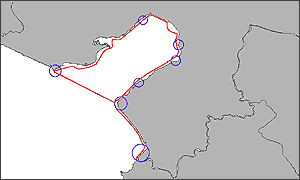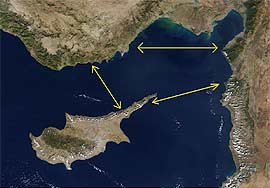

 |
||
 |
||
Vol. 6 (2): December 2003 |
Download this article
|
|
SEEKING ANSWERS IN THE GULF OF ISKENDERUN:
|
 |
|
Figure 1. Survey tracks – Red line is the entire survey track; blue circles are the underwater survey tracks. |
The field survey was mainly conducted to discover caves actively used by seals. The coastal stretch, corresponding to monk seal habitat descriptions (Gucu et al. 2004) were recorded. When such areas were found, an inflatable boat manned by the expert team and composed of one scientist skin diving, one scientist driving the boat and one scientist recording data, surveyed the entire area. In addition to the caves with open access from sea, the coast down to a depth of 30 meters was checked for other caves with underwater entrances. When a cave entrance was found, a team member dived, entered the cave and checked whether an air chamber existed inside. A ROV (Remotely Operated Vehicle) was kept ready to explore the caves located deeper than 15 meters and having an entrance longer than 10 meters. Discovered caves were divided into four categories: Active in which one or more seals were sighted or there was evidence of seal use (e.g. tracks, body depressions, feces), Breeding in which whelping occurs, Abandoned in which seals were historically observed, but are no longer in use, and Potential which meet the requirements and descriptions (1) of a monk seal cave (IUCN/UNEP 1988), but lack any sign of use. Overall, 29 potential caves were discovered; however no seal was sighted during the survey.
Interviews with local fishermen, in an attempt to create a local information network for quick and accurate access to seal sightings from the region, was also undertaken during the survey. The first results revealed a sharp decline in the number of seal sightings after the 1990s. Intensive use of explosives for fishing and the sharp decline in fish stocks were noted as the most probable factors reducing the number of seals. Surprisingly, none of the fishermen interviewed spoke about the harm inflicted by the seals upon their livelihood, a distinct contrast to areas where high seal density exists. Although no sign of hostility against the seal was observed among the local fishermen, deliberate killing should also be considered as a significant factor for the decline, because at least two individuals (one in Turkey [Basusta, pers. comm.] and another in Syria [Mo et al. 2003]) have been deliberately killed within the last 5 years.
Seal sightings reported by the fishermen present a similar pattern: an individual enters an area, is sighted by the majority of the fishermen and disappears shortly after. For instance, the fishermen near the Syrian border reported a seal appearing in spring 2003; it remained in the area for a week or so, and then vanished. The fishermen on the north of the Gulf reported a similar behaviour with a month’s delay, in summer 2003.
Research will continue until December 2004, and it may therefore be too early to speculate or draw conclusions on the basis of first research results. However, the difference in the dates of sightings in different locations may indicate that the area has never hosted a large, resident and isolated seal colony. The seals sporadically sighted in the area are members of a colony based elsewhere, and the home range of the Cilician monk seal is much greater than hitherto believed (Gucu et al. 2004).
The research results carried out on the coasts adjacent to the Gulf of Iskenderun, such as Syria (Mo et al. 2003), southern (Dendrinos & Demetropoulos 2003) and northeastern Cyprus (Gucu et al. 1995) represented very similar results (despite habitat suitability, very few and irregular sightings and no evidence of whelping), posing the question: “where do these sporadically sighted seals come from?"
The only exception to the low seal density areas in the eastern Mediterranean is the Cilician coast, where a resident, breeding colony exists [see The Cilician monk seal colony is growing, this issue].
The project is now testing the hypothesis that the core of the Mediterranean monk seal colony in the eastern Mediterranean is based along the Cilician coast and that a part of the colony, due to as yet unknown reasons, is induced to migrate along the triangle intuitively drawn in figure 2.
 |
|
Figure 2. Hypothetical movements of the seal within the eastern Mediterranean. |
During the next phase, the research will therefore focus on possible seal movements/migrations in the eastern Mediterranean. An Active and Passive infrared monitoring system, which was successfully used to monitor seals on the Cilician coast, will be installed in the newly discovered caves. The system will record seal movements inside a cave, registering date and time. Furthermore, a 35-mm camera with built-in flash will be attached to the recording system. The movement sensor will automatically activate the camera when an event occurs. The recorded data and the films will be retrieved every 3 months, analyzed for activity pattern, and for photo identification of the seal(s) sighted in the region. The outputs will then be compared with the photo-identified seals of the Cilician coast.
The team is now in search of additional funding to expand the research area and to include the northeast of Cyprus Island.
Dendrinos P. and A. Demetropoulos. 2000. The Mediterranean monk seal in Cyprus. Monachus Science III, Monachus Guardian 3 (2): November 2000.
Gucu A.C., H. Örek and A. E. Kideys. 1995. Conservation of the Mediterranean monk seal project. WWF Mersin North Cyprus project. Preliminary Survey report. 22-27 August 1995.
Gucu A.C., F. Erkan and H. Örek. 1997. Conservation of the Mediterranean Monk Seal in Turkey: Mersin and North Cyprus Project, WWF, TR0015-3, 1996-1997 Final Report.
Gucu A.C., F. Erkan and H. Örek. 1998. Conservation of the Mediterranean Monk Seal in Turkey: Mersin and Cilician Basin Project, WWF, TR0015-3, 1997-1998 Final Report.
Gucu A.C., F. Erkan and H. Örek. 1999. Conservation of the Mediterranean Monk Seal in Turkey: Mersin and Cilician Basin Project, WWF, TR0015-3, 1998-1999 Final Report.
Gucu A.C., G. Gucu and H. Örek. 2004. Habitat use and preliminary demographic evaluation of the critically endangered Mediterranean monk seal (Monachus monachus) in the Cilician Basin (Eastern Mediterranean). Biological Conservation 16 (3): 417-431. [Abstract]
IUCN/UNEP. 1988. The Mediterranean Monk Seal. In: Reinjders, P.J.H., de Visscher, M.N., Ries, E., (Eds.), IUCN, Gland, Switzerland: 1-59.
Mo G., M. Gazo, A. Ibrahim, I . Ammar and W. Ghanem. 2003. Monk seal presence and habitat assessment results of a preliminary mission carried out in Syria. Monachus Science III, Monachus Guardian 6 (1): June 2003.
Copyright © 2003 Ali Cemal Gucu, Meltem Ok, Hasan Örek, The Monachus Guardian. All Rights Reserved |